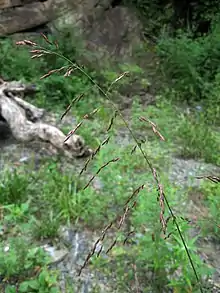Tridens flavus
Tridens flavus, the purpletop tridens,[1] red top, or greasegrass, is a large, robust perennial bunchgrass native to eastern North America.
| Tridens flavus | |
|---|---|
 | |
| Scientific classification | |
| Kingdom: | Plantae |
| Clade: | Tracheophytes |
| Clade: | Angiosperms |
| Clade: | Monocots |
| Clade: | Commelinids |
| Order: | Poales |
| Family: | Poaceae |
| Genus: | Tridens |
| Species: | T. flavus |
| Binomial name | |
| Tridens flavus | |
It widespread throughout its range and is most often found in man-made habitats, such as hay meadows and lawns.
The seeds are purple, giving the grass its common name. The seeds are also oily, leading to its other common name, "greasegrass". It reproduces by seed and tillers.
The grass is often confused with the similar looking Johnson grass (Sorghum halepense), although it is only distantly related. Tridens flavus is easily distinguished by its short, hairy ligule.
It is a larval host to the common wood nymph, crossline skipper, little glassywing, and the Zabulon skipper.[2]
Gallery
.jpg.webp) Individual florets and spikelet
Individual florets and spikelet
References
- "Tridens flavus". Natural Resources Conservation Service PLANTS Database. USDA. Retrieved 15 December 2015.
- The Xerces Society (2016), Gardening for Butterflies: How You Can Attract and Protect Beautiful, Beneficial Insects, Timber Press.
External links
- Samuel Roberts Noble Foundation
- Illinois Wildflowers
- Carrier, Lyman (1917). "False redtop (Tridens flavus; fig 48)". The identification of grasses by their vegetative characters. pp. 24–5. OCLC 8983665.
This article is issued from Wikipedia. The text is licensed under Creative Commons - Attribution - Sharealike. Additional terms may apply for the media files.